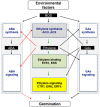Ethylene, a key factor in the regulation of seed dormancy
- PMID: 25346747
- PMCID: PMC4193209
- DOI: 10.3389/fpls.2014.00539
Ethylene, a key factor in the regulation of seed dormancy
Abstract
Ethylene is an important component of the gaseous environment, and regulates numerous plant developmental processes including seed germination and seedling establishment. Dormancy, the inability to germinate in apparently favorable conditions, has been demonstrated to be regulated by the hormonal balance between abscisic acid (ABA) and gibberellins (GAs). Ethylene plays a key role in dormancy release in numerous species, the effective concentrations allowing the germination of dormant seeds ranging between 0.1 and 200 μL L(-1). Studies using inhibitors of ethylene biosynthesis or of ethylene action and analysis of mutant lines altered in genes involved in the ethylene signaling pathway (etr1, ein2, ain1, etr1, and erf1) demonstrate the involvement of ethylene in the regulation of germination and dormancy. Ethylene counteracts ABA effects through a regulation of ABA metabolism and signaling pathways. Moreover, ethylene insensitive mutants in Arabidopsis are more sensitive to ABA and the seeds are more dormant. Numerous data also show an interaction between ABA, GAs and ethylene metabolism and signaling pathways. It has been increasingly demonstrated that reactive oxygen species (ROS) may play a significant role in the regulation of seed germination interacting with hormonal signaling pathways. In the present review the responsiveness of seeds to ethylene will be described, and the key role of ethylene in the regulation of seed dormancy via a crosstalk between hormones and other signals will be discussed.
Keywords: abscisic acid; dormancy; ethylene; gibberellins; reactive oxygen species; seed germination.
Figures


Similar articles
-
Ethylene, a Signaling Compound Involved in Seed Germination and Dormancy.Plants (Basel). 2024 Sep 24;13(19):2674. doi: 10.3390/plants13192674. Plants (Basel). 2024. PMID: 39409543 Free PMC article. Review.
-
ABA crosstalk with ethylene and nitric oxide in seed dormancy and germination.Front Plant Sci. 2013 Mar 26;4:63. doi: 10.3389/fpls.2013.00063. eCollection 2013. Front Plant Sci. 2013. PMID: 23531630 Free PMC article.
-
phyB and HY5 are Involved in the Blue Light-Mediated Alleviation of Dormancy of Arabidopsis Seeds Possibly via the Modulation of Expression of Genes Related to Light, GA, and ABA.Int J Mol Sci. 2019 Nov 23;20(23):5882. doi: 10.3390/ijms20235882. Int J Mol Sci. 2019. PMID: 31771191 Free PMC article.
-
AtPER1 enhances primary seed dormancy and reduces seed germination by suppressing the ABA catabolism and GA biosynthesis in Arabidopsis seeds.Plant J. 2020 Jan;101(2):310-323. doi: 10.1111/tpj.14542. Epub 2019 Oct 22. Plant J. 2020. PMID: 31536657
-
Exploring fine tuning between phytohormones and ROS signaling cascade in regulation of seed dormancy, germination and seedling development.Plant Physiol Biochem. 2024 Feb;207:108352. doi: 10.1016/j.plaphy.2024.108352. Epub 2024 Jan 14. Plant Physiol Biochem. 2024. PMID: 38266558 Review.
Cited by
-
MIKC type MADS-box transcription factor LcSVP2 is involved in dormancy regulation of the terminal buds in evergreen perennial litchi (Litchi chinensis Sonn.).Hortic Res. 2024 May 28;11(7):uhae150. doi: 10.1093/hr/uhae150. eCollection 2024 Jul. Hortic Res. 2024. PMID: 38988620 Free PMC article.
-
Synthesis of fluorescently labeled pyrazole derivative induceing a triple response in Arabidopsis seedlings.J Pestic Sci. 2022 Nov 20;47(4):203-207. doi: 10.1584/jpestics.D22-006. J Pestic Sci. 2022. PMID: 36514690 Free PMC article.
-
Transient induction of a subset of ethylene biosynthesis genes is potentially involved in regulation of grapevine bud dormancy release.Plant Mol Biol. 2018 Dec;98(6):507-523. doi: 10.1007/s11103-018-0793-y. Epub 2018 Nov 3. Plant Mol Biol. 2018. PMID: 30392158
-
Single seeds exhibit transcriptional heterogeneity during secondary dormancy induction.Plant Physiol. 2022 Aug 29;190(1):211-225. doi: 10.1093/plphys/kiac265. Plant Physiol. 2022. PMID: 35670742 Free PMC article.
-
Reactive Oxygen Species (ROS): Beneficial Companions of Plants' Developmental Processes.Front Plant Sci. 2016 Sep 27;7:1299. doi: 10.3389/fpls.2016.01299. eCollection 2016. Front Plant Sci. 2016. PMID: 27729914 Free PMC article. Review.
References
-
- Achard P., Baghour M., Chapple A., Hedden P., Van Der Straeten D., Genschik P., et al. (2007). The plant stress hormone ethylene controls floral transition via DELLA-dependent regulation of floral meristem-identity genes. Proc. Natl. Acad. Sci. U.S.A. 104 6484–6489 10.1073/pnas.0610717104 - DOI - PMC - PubMed
-
- Argyris J., Dahal P., Hayashi E., Still D. W., Bradford K. J. (2008). Genetic variation for lettuce seed thermoinhibition is associated with temperature-sensitive expression of abscisic acid, gibberellin, and ethylene biosynthesis, metabolism, and response genes. Plant Physiol. 148 926–947 10.1104/pp.108.125807 - DOI - PMC - PubMed
Publication types
LinkOut - more resources
Full Text Sources
Other Literature Sources

